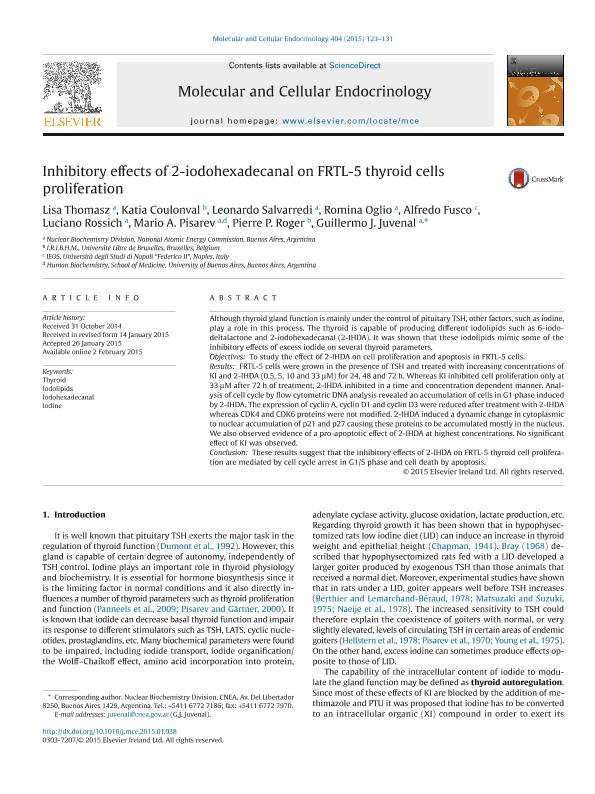Artículo
Inhibitory effects of 2-iodohexadecanal on FRTL-5 thyroid cells proliferation
Thomasz, Lisa ; Coulonval, Katia; Salvarredi, Leonardo Andres
; Coulonval, Katia; Salvarredi, Leonardo Andres ; Oglio, Andrea Romina
; Oglio, Andrea Romina ; Fusco, Alfredo; Rossich, Luciano Esteban
; Fusco, Alfredo; Rossich, Luciano Esteban ; Pisarev, Mario Alberto
; Pisarev, Mario Alberto ; Roger, Pierre P.; Juvenal, Guillermo Juan
; Roger, Pierre P.; Juvenal, Guillermo Juan
 ; Coulonval, Katia; Salvarredi, Leonardo Andres
; Coulonval, Katia; Salvarredi, Leonardo Andres ; Oglio, Andrea Romina
; Oglio, Andrea Romina ; Fusco, Alfredo; Rossich, Luciano Esteban
; Fusco, Alfredo; Rossich, Luciano Esteban ; Pisarev, Mario Alberto
; Pisarev, Mario Alberto ; Roger, Pierre P.; Juvenal, Guillermo Juan
; Roger, Pierre P.; Juvenal, Guillermo Juan
Fecha de publicación:
03/2015
Editorial:
Elsevier Ireland
Revista:
Molecular and Cellular Endocrinology
ISSN:
0303-7207
Idioma:
Inglés
Tipo de recurso:
Artículo publicado
Clasificación temática:
Resumen
Although thyroid gland function is mainly under the control of pituitary TSH, other factors, such as iodine, play a role in this process. The thyroid is capable of producing different iodolipids such as 6-iodo-deltalactone and 2-iodohexadecanal (2-IHDA). It was shown that these iodolipids mimic some of the inhibitory effects of excess iodide on several thyroid parameters. Objectives: To study the effect of 2-IHDA on cell proliferation and apoptosis in FRTL-5 cells. Results: FRTL-5 cells were grown in the presence of TSH and treated with increasing concentrations of KI and 2-IHDA (0.5, 5, 10 and 33 μM) for 24, 48 and 72 h. Whereas KI inhibited cell proliferation only at 33 μM after 72 h of treatment, 2-IHDA inhibited in a time and concentration dependent manner. Analysis of cell cycle by flow cytometric DNA analysis revealed an accumulation of cells in G1 phase induced by 2-IHDA. The expression of cyclin A, cyclin D1 and cyclin D3 were reduced after treatment with 2-IHDA whereas CDK4 and CDK6 proteins were not modified. 2-IHDA induced a dynamic change in cytoplasmic to nuclear accumulation of p21 and p27 causing these proteins to be accumulated mostly in the nucleus. We also observed evidence of a pro-apoptotic effect of 2-IHDA at highest concentrations. No significant effect of KI was observed. Conclusion: These results suggest that the inhibitory effects of 2-IHDA on FRTL-5 thyroid cell proliferation are mediated by cell cycle arrest in G1/S phase and cell death by apoptosis.
Palabras clave:
IODINE
,
IODOHEXADECANAL
,
IODOLIPIDS
,
THYROID
Archivos asociados
Licencia
Identificadores
Colecciones
Articulos(SEDE CENTRAL)
Articulos de SEDE CENTRAL
Articulos de SEDE CENTRAL
Citación
Thomasz, Lisa; Coulonval, Katia; Salvarredi, Leonardo Andres; Oglio, Andrea Romina; Fusco, Alfredo; et al.; Inhibitory effects of 2-iodohexadecanal on FRTL-5 thyroid cells proliferation; Elsevier Ireland; Molecular and Cellular Endocrinology; 404; 3-2015; 123-131
Compartir
Altmétricas



